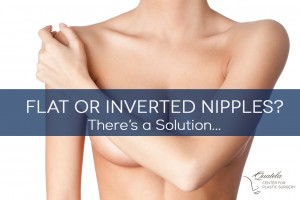 Inverted nipples. Have you ever had a conversation about them? Chances are probably not. But did you know that inverted nipples are actually a lot more common than people realize? About 10-20% of women, and many men, have inverted or flat nipples. That means that inverted nipples are more common than having blue or green eyes. Unfortunately, there isn’t a lot of information about them, therefore causing women, and men, who are embarrassed by the condition to suffer in silence. It’s important to know that this isn’t a new issue and that you are not alone.
Inverted nipples. Have you ever had a conversation about them? Chances are probably not. But did you know that inverted nipples are actually a lot more common than people realize? About 10-20% of women, and many men, have inverted or flat nipples. That means that inverted nipples are more common than having blue or green eyes. Unfortunately, there isn’t a lot of information about them, therefore causing women, and men, who are embarrassed by the condition to suffer in silence. It’s important to know that this isn’t a new issue and that you are not alone.
What is an inverted nipple?
Inverted nipples simply go inward, or lay flat against the chest, instead of protruding outwards.
What causes inverted nipples?
An inverted nipple is caused by tissue in the breast that is attached tightly to the inside of the nipple skin. This pulls it inward toward the inside of the chest. The force of tight, shortened milk ducts can be greater than the muscle in the nipple that pulls it outwards, causing the inversion.
Nipples can be inverted from birth or invert later in life. Nipple inversion is often times genetic and exists at birth or happens during puberty as the breasts develop. If it’s not genetic, inversion can happen due to constricted milk ducts, scarring of the milk ducts due to breastfeeding, or a lack of skin at the base of the nipple.
It is important to note that if you have never had inverted nipples before and they change, this can be a cause for concern and should be mentioned to your doctor. Unfortunately, new nipple inversion can indicate breast cancer so it is best to speak to your healthcare provider to ensure that is not the case.
What can I do to fix it?
In order to permanently correct inverted nipples, a minor procedure is usually necessary. This is done in the office under local anesthesia and takes less than an hour. Two stitches are placed underneath the nipple to create a pad for it to sit on and remain outward.
Is the procedure painful or require a long recovery?
A local anesthetic is used during inverted nipple correction and there may be slight discomfort when that wears off. However, discomfort usually does not last longer than a week. Patients are able to return to work after the procedure but are asked to avoid exercise and strenuous activity that would cause rubbing against the nipple area for about a week.
Does inverted nipple repair change the ability to breastfeed?
Since the milk ducts are divided or lengthened during the inverted nipple procedure, breastfeeding will not be possible afterwards. This is something that you need to consider prior to the procedure and perhaps decide to have your nipples corrected after breastfeeding is complete.
You don’t have to live with embarrassment any longer. If you are interested in a private consultation with Dr. Koenig, board certified plastic surgeon, about inverted nipple correction, please call our office at (585) 244-1000.



